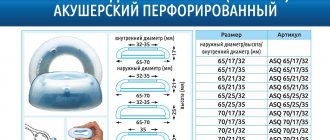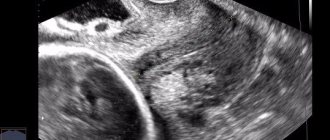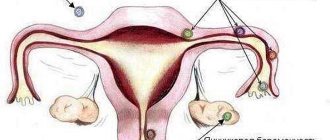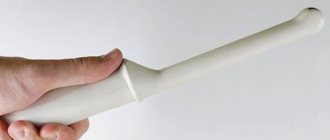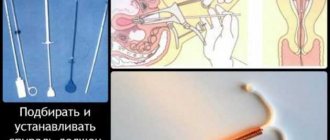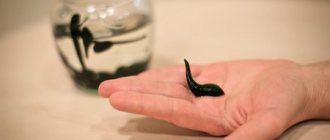What is an obstetric pessary and what is it for?
A uterine ring can be placed on the cervix to correct anatomical or functional isthmic-cervical insufficiency. Installation of this device is an alternative option for surgical correction of ICI when carrying a child.
What is a pessary? Most often, the product is made in the shape of a concave pyramid from a series of connected rings, which are distinguished by smooth semicircular edges. The wide part of the device is directed towards the rectum, and the narrow part is directed towards the location of the pubic symphysis.
Compression of nearby organs does not occur due to the concave shape of the bases. The central part of the structure has a hole shifted to a wide base. To the side of the central hole there are holes of smaller diameter, the presence of which allows the discharge of secretions. There are jumpers between them, which are necessary to maintain the rigidity of the structure.
The mechanism of action of the device is based on the following components:
- reducing the load on the cervix due to the redistribution of fetal pressure;
- prevention of premature opening of the cervix;
- closing the cervix with the walls of the hole in the middle of the device;
- preservation of the mucus plug in the cervix, reducing the risk of infection.
Obstetric pessary unloading UNONA Belarus - reviews
I was fitted with the Juno obstetric pessary at the end of the 19th week. After measuring the cervix, the ultrasound specialist reported that 2.5 cm is very small and it is imperative to remove the threat of premature birth. I was admitted to the perinatal center with a diagnosis of ICI on the same day.
ICI (isthmic-cervical insufficiency) - under pressure from the fetus, the cervix shortens and opens prematurely. The two most common methods for correcting ICI are pessary placement and surgical cervical suturing.
An obstetric pessary (uterine ring) is a plastic or silicone ring designed to maintain the cervix in the desired position. Installation of a pessary during pregnancy serves to prevent premature birth in women with ICM.
Installing a pessary is the simplest and bloodless method. Hemming is carried out under anesthesia; it often seriously injures the neck, increases the risk of developing bacterial infections, and can later lead to the cutting of stitches. This can tear your cervix to shreds. In short, the doctor at the perinatal center decided to give me a uterine ring “with petals” (photo).
Obstetric pessary Juno No. 1
3 sizes of uterine rings
Situation before pessary installation:
— From 18 to 19 weeks I felt a constant heaviness in the lower abdomen.
— From the 19th week, a strong and frequent tone began to appear when walking and sitting for long periods of time.
- Shortened cervix and threat of premature birth.
Installation mechanism
Installation of the pessary, sensations:
After examination, pessary No. 1 was chosen. The doctor promised that there would be almost no pain, he asked me to relax, take a sharp breath and hold the air.
Aaaand... oops!
A sharp pain forced him to arch, and the next moment the head of the department was kicked in the jaw
Well, okay, it’s my own fault - I shouldn’t have lied about the fact that it wouldn’t hurt... Then I would have been ready.
After installing the pessary:
They kept me in the hospital for another 2 days - “just in case” and put on a couple more IVs for the baby. In general, after installing the pessary there are no particular sensations. The first day there was psychological discomfort from the knowledge that there would be a foreign body inside. Removal of the pessary is approximately scheduled only for the 36th week.
Limitations and inconveniences:
— No sex
This is sad. But if you consider that with ICI any sexual activity would be completely contraindicated anyway, then we can assume that nothing has changed.
— The doctor said that removing the pessary can also be a rather unpleasant procedure.
“I read that after installing a pessary, the cervix is so unloaded that it cannot naturally prepare for childbirth in time and loses its elasticity. As a result, neck ruptures are more likely. True, the doctor said that this is all very individual. To be honest, I am very afraid of breakups, but since there is still no alternative, then there is no point in worrying.
— Ultrasound monitoring of the cervix every 2 weeks and mandatory monitoring of microflora every 2 weeks are required.
— Increased likelihood of microflora disturbances.
The advantages of installing a pessary in general and specifically the Juno pessary:
— The ban on physical activity is greatly reduced. Once again you can walk freely, drive and do all your homework. It is still prohibited to ride a horse, bungee jump, or squat with a barbell.
- The tone has decreased significantly.
— The doctor said that after installing a pessary, the risk of premature birth is reduced by about 85%. So we hope for the best.
“Purely psychologically it became easier. The panic has passed.
— If a Juno pessary is installed, then if an imbalance of microflora occurs, you can prescribe any suppositories allowed during pregnancy. When installing imported pessaries, the list of possible drugs is significantly limited. The doctor said that the Juno pessary is more unpretentious in this regard.
At the moment, the uterine ring has been in place for almost 4 weeks. I hope that everything will continue to go well and thanks to this thing, after the 36th week we will safely see our baby.
Perhaps, as I wear the pessary, I will add to the review. So far everything is satisfactory and gives hope for the best.
I would be glad if someone finds the information they need in my review. But I don’t wish anyone to get into the same situation!
*******************************************************
ADDITION:
Due to external reasons, my pessary rotated and moved along the back wall at 34 weeks. Thus, ceasing to unload and hold the cervix. I had to take it off. But it still fulfilled its main function and helped carry the pregnancy to an almost safe term. Now I'm sitting here waiting for the birth
*******************************************************
ADDITION:
Safely gave birth at 37.5 weeks
HOORAY!!!
*******************************************************
Types of obstetric pessaries
Pessary during pregnancy
This product is also called a uterine ring and is used to maintain pregnancy by fixing it on the cervix. However, in gynecology it can be used not only during pregnancy, but also during uterine prolapse. There are several varieties of these devices used in gynecological practice:
- Urethral. They are distinguished by their ring-shaped shape, thickened outward. Used for simultaneous fixation of the urethra and uterus.
- Cup perforated. They are distinguished by their cup-shaped shape. It has a large hole or perforations. Used in cases of initial and moderate degree of uterine prolapse.
- Calyceal-urethral. They combine the design features of previous types of devices.
- Cubic perforated. They are a cubic device, the walls of which are concave inward. A cubic pessary has a hole designed to drain secretions. It is used in cases of severe uterine prolapse. It is worn for a short period of time (from 8 to 12 hours).
- Mushroom-shaped. Looks like a ring on a leg, used in case of severe prolapse of the uterus. Removed during the night's rest.
- Hodge device. It is used in special situations when a woman’s uterus and vagina have certain anatomical features. Can take various forms.
- Thin and thick rings are used for the initial degree of prolapse. The thin one maintains its shape due to the internal metal spring, and the thick one thanks to its thickness.
When Ginipral is prescribed to pregnant women
Quite often, a midwife pessary is used in one of the following varieties:
- Arabin. It is made of silicone, the country of origin is Germany. It has the shape of a bowl, in the side parts of which there are perforations.
The assortment includes several standard sizes of the device, the specific one of which is selected based on the number of fetuses, the number of births in the anamnesis, the presence of changes in the cervical canal, and the type of opening of the internal pharynx. The dimensions of the device differ in terms of height and diameter. The device is produced in non-sterile form.
- Juno. It is made of plastic, the country of production is the Republic of Belarus. It is distinguished by its flat shape and has the appearance of a trapezoid due to the presence of additional rings. Sold sterile and available in several sizes.
“Juno” device
In obstetric practice, these types of products are common because they are reliable and do not cause discomfort or complications when worn.
What is the remedy for?
Let us dwell in more detail on why exactly a pessary is needed during pregnancy. The fact is that not all expectant mothers fully understand this. Not much evidence:
- suture failure after surgical treatment of isthmic-cervical insufficiency;
- prevention of ICN.
These are exactly the conditions where the cervix is very soft or short and therefore dilates prematurely, causing miscarriage or labor.
Sometimes necessary for prevention
The ring allows you to preserve the process of bearing a child and prolong a pregnancy that is in danger of failure. Often the device has to be installed when carrying twins or triplets. It prevents premature birth in women diagnosed with ICI and those carrying multiple pregnancies. However, this device should not be the only treatment for ICI.
An unloading obstetric pessary allows you to keep the cervix closed, relieve tension from it and prevent premature softening. In addition, the pressure on the cervix is reduced.
Many women are very worried when they are prescribed a pessary during pregnancy, look for photos of the device on the Internet and read reviews of those who have encountered the same problem. At the same time, it is with the obstetric ring that the process of bearing a baby will go smoothly.
However, there are several contraindications to ring installation. First of all, there is a suspicion of a frozen pregnancy. In addition, the procedure is prohibited if an inflammatory process appears in the genitals, or if bloody discharge appears from the vagina.
Features of device installation
Previously, it was possible to suture the uterus only from the 20th week of pregnancy, since anesthesia had to be used. Nowadays, pessary installation is possible during earlier pregnancy. You just need to choose a certain type of ring. But most often the device is installed after 20 weeks. Usually between 28 and 33 weeks.
First of all, it is necessary to prepare the genital tract. To do this, it is necessary to carry out sanitation.
If there is any infection (thrush, for example), it will worsen while wearing the ring. Usually, the doctor prescribes vaginal suppositories for treatment or prevention, and only after that the vaginal ring is installed.
Probably every woman is interested in how exactly the doctor will place a pessary during pregnancy. The procedure is simple and takes minimal time. It will take literally a few minutes. The woman empties her bladder and then sits in the gynecological chair. The doctor carefully inserts the ring through the vagina and installs it, after bending it. Before installation, the ring is lubricated with glycerin or any other moisturizer to facilitate its insertion into the vagina by increasing slip.
Woman feels discomfort when moving
Everyone’s sensitivity threshold is different, so during pregnancy, some girls will think about whether it hurts to put on an obstetric pessary. Sometimes girls report severe pain, but doctors say that this is normal discomfort and psychosomatics. The discomfort, although unpleasant, is bearable.
If the uterus is toned or highly sensitive, then half an hour before the procedure you need to take an antispasmodic. This will make it easier to move the installation of the ring. Doctors do not use anesthesia for this procedure. During pregnancy, a woman usually does not experience pain after installing a pessary.
It is necessary to pay special attention to the care of the device. After installation, the doctor tells the woman exactly how to care for the pessary during pregnancy. First of all, you need to maintain physical peace. Having sex is prohibited. Sometimes you have to use vaginal suppositories to prevent the development of sexually transmitted infections.
The doctor must monitor the condition of the vaginal microflora, so a smear is taken every 3 weeks. You will also have to regularly go for a gynecological examination so that the doctor monitors the correct placement of the device and possible complications. You should not touch the pessary yourself or try to adjust or remove it.
Can the ring fall off?
The expectant mother will feel the ring when changing position
Usually women quickly get used to vaginal rings. They do not cause discomfort and are almost not felt. However, during pregnancy, many people worry about whether the ring (pessary) might fall off. Yes, this happens. But this is rather an exception to the rule. Usually, the main reason for this is that the ring is too large or the installation rules are not correct. When the device moves out of place, the woman immediately begins to feel that it is pressing. The expectant mother will feel it when changing position, it will be uncomfortable for her to sit.
If your doctor has selected the right ring size and you follow all the instructions, there is no reason to worry. The likelihood that the device will fly off is minimal. Sometimes girls feel that the pessary is set too low, because when washing it you can feel it. If you feel the sensations described above, you should not touch the vagina again. The main thing is not to forget about regular examinations with your gynecologist.
During pregnancy, the doctor individually selects an obstetric pessary. The shape and size of the device must correspond to the size and anatomical features of the woman’s internal genital organs.
To manufacture the unloading obstetric ring, safe, hypoallergenic, biological materials are used. Usually special plastic or silicone, elastic, flexible, so it easily adapts to the female anatomy. At the same time, it is quite dense. The pessary has a shelf life during which it is sterile. Please note that the device is disposable.
Discharges after installation
Sometimes you have to see a doctor ahead of schedule. In some cases, vaginal discharge may occur while wearing the device. You should immediately inform your doctor about this. Discharges are:
- bloody, cinnamon;
- greenish or yellow;
- liquid, odorless and colorless.
Be aware that a pessary installed during pregnancy very often causes an increase in leucorrhoea. This is a completely natural phenomenon. But some time after the procedure, clear liquid discharge appears in large quantities. This phenomenon means that the body is trying with all its might to get rid of a body that is foreign to it. If you are still worried that something has gone wrong, it is worth taking a water leak test.
Bloody or brown discharge may occur immediately after the ring is inserted. They are usually quite scarce. There is no need to worry about this. If they occur while wearing the ring, you should immediately call a doctor.
Why install an obstetric pessary
The list of indications for installing the product during pregnancy includes:
- organic or functional isthmic-cervical insufficiency;
- prevention of dehiscence of sutures that were placed on the cervix during surgical correction of cervical incompetence;
- multiple pregnancy, which has an increased risk of early delivery;
- increased risk of developing ICI;
- aggravated medical history (including recurrent miscarriage).
Most of the clinical situations requiring the use of these devices are associated precisely with cervix failure. It is determined using ultrasound, assessing the length and width of the cervix, as well as the condition of the cervical canal and internal os.
The results of cervicometric studies are compared with the gestation period to determine the advisability of corrective measures.
In such a clinical situation as true isthmic-cervical insufficiency (hyperandrogenism of ovarian or adrenal origin), in addition to the installation of the uterine ring, it is necessary to take certain medications that suppress excess amounts of male sex hormones (such drugs include Dexamethasone).
In the case of uterine tone, it is rational to prescribe tocolytic drugs (Azotiban), since constant tone can provoke early maturation of the cervix.
Multiple pregnancy is a factor in the development of ICI
Which is better: sutures or pessary
Previously, only a surgical method was used to correct ICI - a suture was placed on the neck. However, this invasive technique was replaced by a gentle decision on the possibility of installing a special fixing device. This method has the following positive features compared to surgical correction:
- non-invasive;
- reducing the risk of infection;
- the possibility of installation in an outpatient setting (that is, there is no need for hospitalization);
- no need for anesthesia;
- ease of installation;
- absence of traumatic effects on the cervix and amniotic sac, that is, absence of a stimulating effect on labor;
- less frequent development of disturbances in the natural balance of vaginal flora.
Cervix during pregnancy: what lengths are normal
However, you need to understand that some clinical situations may require suturing with subsequent installation of the uterine ring, that is, there is not always a need for surgical correction measures.
The appropriateness of both methods is determined by the doctor depending on the clinical situation and the presence of contraindications, so it is impossible to unequivocally answer the question of which is better: sutures or a pessary.
The mechanism for installing a pessary during pregnancy
You should understand in detail how the pessary is placed. This product is installed between 16 and 34 weeks, most often in the second trimester.
Before installation, some preparation is required, which includes the following activities:
- Exclusion of infectious and inflammatory diseases in the female genital tract. Carrying out rehabilitation if the situation requires it. At this stage, it is necessary to take a cervical smear and biomaterial from the cervix for bacterial culture to identify susceptibility to medications.
- If the study revealed an increased number of leukocytes, while there was no growth of pathogens, the doctor prescribes a course of suppositories with antiseptic components. In some cases, the prescription of antibiotic drugs is required.
- Immediately before the administration procedure, you should empty your bladder.
- An hour before installation, antispasmodics (drotaverine) are taken.
The installation procedure itself is carried out on a gynecological chair, lasts several minutes and must be performed subject to sanitary rules. The following stages of ring insertion are provided:
- if the device itself is non-sterile, then before installation it must be disinfected according to the instructions;
- before installation, the specialist must wash his hands with soap twice, then perform an antiseptic treatment, and then put on sterile disposable gloves;
- antiseptic treatment of the vagina and cervix is carried out;
- the device is lubricated with a sterile glycerin solution;
- the doctor installs the product;
- If the size is correct and installed correctly, the pregnant woman does not feel the device; to make sure of this, the specialist may ask the woman to cough.
When and how to place a pessary
Deadlines. Most often, the doctor places an obstetric pessary after the 20th week of pregnancy. But if there are indications, this can be done earlier - starting from the 13th week.
Exploratory survey. First, a woman should consult a gynecologist and undergo an examination - tests to determine the bacterial cleanliness of the vagina. The doctor must determine the type and size of the obstetric pessary and make sure that there are no inflammatory processes in the vagina and prerequisites for it. In the presence of genitourinary infections, a course of treatment is first carried out.
Installation of a pessary. Before the procedure, the woman must empty her bladder in advance. If the uterus is in increased tone, the patient is given an antispasmodic half an hour to an hour before the procedure. Installation of the pessary is unpleasant, but does not cause pain, since it is made of elastic materials and is inserted in a folded state, pre-lubricated with glycerin or petroleum jelly. A silicone pessary is easier to insert than a plastic one. According to women's reviews, the sensations during the procedure are quite tolerable. The doctor inserts the pessary deep into the vagina and straightens it there, reliably fixing the cervix in a closed state, ensuring uniform distribution of the load created by the growing fetus over the entire lower segment of the uterus.
A pessary selected in size and correctly installed does not cause any inconvenience to the patient. If discomfort is present/appears, you should see a doctor. Displacement of the pessary is easily diagnosed and corrected during a gynecological examination.
Make an appointment with a gynecologist
How to behave after installing a pessary
After this procedure, the woman is recommended to take vaginal smears every 2-3 weeks in order, if necessary, to identify colpitis in time and take measures to correct it. Also, after installing the pessary, an ultrasound examination of the cervix is performed every 3-4 weeks to assess its condition. Every two weeks, the device and vagina are antiseptically treated with chlorhexidine and furatsilin.
How to use indomethacin suppositories during pregnancy
If a woman has an obstetric pessary, she should:
- exclude active sex life, lifting heavy things, taking a bath and swimming in a pool or open water;
- regularly visit a gynecologist for smears and antiseptic treatment;
- monitor the nature of vaginal discharge - if there are pathological changes, you should immediately seek medical help.
Positive emotions and sexual peace are important for a pregnant woman
pessary doctor arabin
Hello, I decided to write to the community about my experience with an obstetric pessary, because... I myself was constantly looking for information about this, but as it turned out, there is not so much of it on the Internet, although from the comments you can see that not just a few, but many women are given them.
They put it on me at 26 weeks of pregnancy, because... The cervix began to shorten and the internal os began to open. They placed it urgently, immediately after cervicometry, so I didn’t have to choose, and I bought the pessary at the pharmacy that suited my parameters. It was Doctor Arabin for 5550 thousand rubles, the pharmacy said that you can order another one cheaper, but you will have to wait about a week for it, which did not suit me, because... Before that, I had 2 unsuccessful pregnancies and I was afraid that nothing would happen.
It didn’t hurt to put it in, it was a little unpleasant, it lasted about a minute, before it was put in I wasn’t afraid at all because... I didn’t even have time to go online and didn’t even know what it was, I was scared only when I saw it, a silicone ring with a diameter of about 7 cm, but after they put it in, I immediately felt better, the feeling of heaviness in the lower abdomen went away and somehow... then walking became easier.
The first week I was afraid to go to the toilet, especially in large quantities, I thought that it would fall off, because... I didn’t feel it at all, but the gynecologist reassured me that if it came off, I would definitely feel it and I slowly calmed down.
I carried out sanitation with Hexicon vaginal tablets, 2 times during the entire period, for 5 days, as prescribed by the doctor, after a smear.
After the pessary was installed, the discharge became a lot and somehow not regularly, one day was enough for me 1 daily, and on the other I could change 3 of them, apparently the discharge in the pessary accumulated and at some point flowed out. I even did a test for water leakage, which showed me that it was not water, I was not satisfied with this, and I also went for an ultrasound to make sure, but it turned out that it was still due to the pessary.
As the pregnancy progressed, constipation began, the gynecologist prescribed me to drink Duphalac, at first it helped, later I also added oat bran to my daily diet, and then sometimes I started using glycerin suppositories, because... the pessary sank very low and what had accumulated below did not pass and the intestines hurt terribly, there was straight colic in the lower abdomen.
But discharge and constipation are the only consequences that I had after installing the pessary, in order to avoid miscarriage or premature birth, I calmly endured it all, otherwise everything was in perfect order.
When it was 38 weeks (more precisely, 37 and 4), the pessary was removed from me, it also took no more than 30 seconds, there was no pain and there was not even an unpleasant sensation, I didn’t even understand that it had already been removed, although during the examination the gynecologist told me, that it costs me very well and firmly. After removing the pessary, there was no pain or discharge and there was less of it; it’s already been 3 days and so far everything is fine.
This is my experience with a pessary, maybe it will be useful for someone.
Possible complications while wearing
The list of possible adverse reactions after installation of the device includes:
- discomfort after prolonged sitting;
- displacement of the product and its movement into the vagina, which provokes the progression of colpitis;
- increased nature of vaginal discharge.
If colpitis is detected, then therapeutic measures are taken; if they do not have the desired effect within 10 days, the pessary is removed.
Another serious complication is chorioamnionitis, that is, an inflammatory process affecting the membranes of the amniotic sac and causing infection in the amniotic fluid.
You should also remember that if the size is incorrectly selected, the device may move and fall out, in which case a more suitable device must be inserted.
Discharges after installation
Wearing the device may cause an increase in the volume of discharge from the cervical canal. Normally, they should be translucent or white, there is no itching. This is a physiological reaction of the body to the introduction of a foreign object.
It is important to remember that if the nature of the discharge changes, it becomes yellowish or greenish and is accompanied by uncomfortable sensations, then you should contact a specialist to determine measures to correct the condition.
